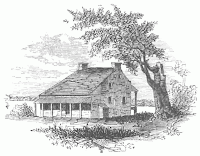In late December of 1779 Christopher Billop the owner of Billop House located on Staten Island
in New York accused one of his female servants of spying on him for the
Colonists. The American Revolutionary war had commenced and Billop was an avid
British loyalist. He very large in statue was known to be a man with a
violent temper. A colonel, he led a Tory detachment during the Revolutionary War and despised any who fought against
the English.
When he accused this female
servant of spying on him she vehemently denied his charges. This enraged Billop
who then grabbed her and threw her down the stairs. She died of a broken neck
and Billop was never accused or tried for her murder. Billop and this serving girl have haunted Billop House for 223 years.
The ghosts of British soldiers are also seen on the property.
Billop House or Bentley Manor
** is a stately stone mansion that was built in 1680 on 1,600 acres of land. The Colonel inherited this home -- his great grandfather built it. This house overlooks Staten Island Sound, specifically Raritan Bay. The mansion includes:
a spacious attic, two floors each with three rooms, a large basement kitchen
and a secret tunnel. This tunnel leads from the home’s root cellar to the edge
of Staten Island Sound. Three years before Billop murdered his servant girl
this tunnel was used for the only official peace conference between the British
and Colonists during the war.
 |
| Light green area is Raritan Bay |
In 1776 the war was not going
well for the Colonists. The British controlled New Your City, Staten and Long
Islands. The Colonists in September were near defeat so it was
arranged by Lord Richard Howe to meet with Benjamin Franklin, Edward Rutledge
and John Adams at Billop House. Howe after emphasizing that the British
intended to end the Revolution and crush its leaders offered to end the war if
the Colonists would swear allegiance to England.
Considering this tone it is
not a surprise that Adams and the others refused this offer. Colonel Billop
took great delight in the fact that these talks ended the first day. He felt
these traitors to England would shortly be destroyed. After this Billop’s
mansion was given a new nickname, “Conference House”. Billop was very happy his
home now symbolized his loyalty to the British and even more important
England’s power.
Throughout the war Billop
opened his home to British soldiers that needed to rest--his large basement
kitchen was converted into a hospital. Often soldiers were smuggled into his
home at night through the tunnel. Soldiers that died at the home were hastily
buried around the large estate for there was no time for funerals. It is stated
this is most likely the reason why the ghosts of British soldiers wearing
redcoats are still seen on the property today.
Billop’s vehemence toward
patriots during the war made him a target. He was kidnapped and held for ransom
twice. In June of 1779 a group of patriots rowed across from Perth Amboy in New
Jersey. Billop was held for two months. The second time he was kidnapped was in
November of the same year. Both times he was held as a P.O.W. in the Burlington
County jail in New Jersey. He was chained to the floor and only fed bread and
water. He was told this was retaliation for prisoners held by the British. The second time he again was held for two months and then released just after Christmas.
When Billop returned home he
was convinced that one of his servants had aided in these kidnappings. He had
seen a servant girl place a lantern in a second floor window, which he felt
must have been a signal to the men supposedly hidden at a church steeple in
Perth Amboy. When next he saw this servant girl place a lantern in this window
he went mad.
“He bellowed at her and then threw her down a flight
of stairs killing her.”
It was mentioned after this
that the poor girl was just doing one of her nightly chores. Billop had her
body buried in an unmarked grave on the property.
 |
| Bentley Manor or Billop House Rear view |
When the war ended Billop
fled to New Brunswick, Canada where he lived until he died at the age of ninety
in 1827. In 1783 Billop House was confiscated by the state of New York. Over
the years it was used first as a multi-family home, a 19th century
hotel and then a rat-poison factory. In 1929 a non-profit organization called Conference House Association prevented
the house from being torn down, they have maintained it ever since. The grounds
today consist of only 226 acres and the property is now called Conference Park.
This association does not allow paranormal investigations.
For years neighbors have
reported that the home and property appear to be haunted. Reports include:
soldiers wearing redcoats wandering the gardens, kitchen and the tunnel. A man
has been heard singing and others have reported being tapped on the shoulder by an unseen hand. Many state that there is a residual haunting of the murder. A man
is heard shouting loudly, then a woman screams as sounds of her falling are
heard. This struggle is heard over and over again.
The servant girl’s grave has
never been found and the exact number of ghosts and their names, except
Billops, has never been discovered.
* Billop House is the only pre-Revolutionary
manor house still surviving in New York City. It was added to the National
Register of Historic Places in 1982.






.jpg)
















